Xinyuan Wang
Graph AI generates neurological hypotheses validated in molecular, organoid, and clinical systems
Dec 13, 2025Abstract:Neurological diseases are the leading global cause of disability, yet most lack disease-modifying treatments. We present PROTON, a heterogeneous graph transformer that generates testable hypotheses across molecular, organoid, and clinical systems. To evaluate PROTON, we apply it to Parkinson's disease (PD), bipolar disorder (BD), and Alzheimer's disease (AD). In PD, PROTON linked genetic risk loci to genes essential for dopaminergic neuron survival and predicted pesticides toxic to patient-derived neurons, including the insecticide endosulfan, which ranked within the top 1.29% of predictions. In silico screens performed by PROTON reproduced six genome-wide $α$-synuclein experiments, including a split-ubiquitin yeast two-hybrid system (normalized enrichment score [NES] = 2.30, FDR-adjusted $p < 1 \times 10^{-4}$), an ascorbate peroxidase proximity labeling assay (NES = 2.16, FDR $< 1 \times 10^{-4}$), and a high-depth targeted exome sequencing study in 496 synucleinopathy patients (NES = 2.13, FDR $< 1 \times 10^{-4}$). In BD, PROTON predicted calcitriol as a candidate drug that reversed proteomic alterations observed in cortical organoids derived from BD patients. In AD, we evaluated PROTON predictions in health records from $n = 610,524$ patients at Mass General Brigham, confirming that five PROTON-predicted drugs were associated with reduced seven-year dementia risk (minimum hazard ratio = 0.63, 95% CI: 0.53-0.75, $p < 1 \times 10^{-7}$). PROTON generated neurological hypotheses that were evaluated across molecular, organoid, and clinical systems, defining a path for AI-driven discovery in neurological disease.
Dataforge: A Data Agent Platform for Autonomous Data Engineering
Nov 09, 2025Abstract:The growing demand for AI applications in fields such as materials discovery, molecular modeling, and climate science has made data preparation an important but labor-intensive step. Raw data from diverse sources must be cleaned, normalized, and transformed to become AI-ready, while effective feature transformation and selection are essential for efficient training and inference. To address the challenges of scalability and expertise dependence, we present Data Agent, a fully autonomous system specialized for tabular data. Leveraging large language model (LLM) reasoning and grounded validation, Data Agent automatically performs data cleaning, hierarchical routing, and feature-level optimization through dual feedback loops. It embodies three core principles: automatic, safe, and non-expert friendly, which ensure end-to-end reliability without human supervision. This demo showcases the first practical realization of an autonomous Data Agent, illustrating how raw data can be transformed "From Data to Better Data."
Distribution Shift Aware Neural Tabular Learning
Aug 27, 2025



Abstract:Tabular learning transforms raw features into optimized spaces for downstream tasks, but its effectiveness deteriorates under distribution shifts between training and testing data. We formalize this challenge as the Distribution Shift Tabular Learning (DSTL) problem and propose a novel Shift-Aware Feature Transformation (SAFT) framework to address it. SAFT reframes tabular learning from a discrete search task into a continuous representation-generation paradigm, enabling differentiable optimization over transformed feature sets. SAFT integrates three mechanisms to ensure robustness: (i) shift-resistant representation via embedding decorrelation and sample reweighting, (ii) flatness-aware generation through suboptimal embedding averaging, and (iii) normalization-based alignment between training and test distributions. Extensive experiments show that SAFT consistently outperforms prior tabular learning methods in terms of robustness, effectiveness, and generalization ability under diverse real-world distribution shifts.
Data-Efficient Symbolic Regression via Foundation Model Distillation
Aug 27, 2025Abstract:Discovering interpretable mathematical equations from observed data (a.k.a. equation discovery or symbolic regression) is a cornerstone of scientific discovery, enabling transparent modeling of physical, biological, and economic systems. While foundation models pre-trained on large-scale equation datasets offer a promising starting point, they often suffer from negative transfer and poor generalization when applied to small, domain-specific datasets. In this paper, we introduce EQUATE (Equation Generation via QUality-Aligned Transfer Embeddings), a data-efficient fine-tuning framework that adapts foundation models for symbolic equation discovery in low-data regimes via distillation. EQUATE combines symbolic-numeric alignment with evaluator-guided embedding optimization, enabling a principled embedding-search-generation paradigm. Our approach reformulates discrete equation search as a continuous optimization task in a shared embedding space, guided by data-equation fitness and simplicity. Experiments across three standard public benchmarks (Feynman, Strogatz, and black-box datasets) demonstrate that EQUATE consistently outperforms state-of-the-art baselines in both accuracy and robustness, while preserving low complexity and fast inference. These results highlight EQUATE as a practical and generalizable solution for data-efficient symbolic regression in foundation model distillation settings.
OpenCUA: Open Foundations for Computer-Use Agents
Aug 12, 2025Abstract:Vision-language models have demonstrated impressive capabilities as computer-use agents (CUAs) capable of automating diverse computer tasks. As their commercial potential grows, critical details of the most capable CUA systems remain closed. As these agents will increasingly mediate digital interactions and execute consequential decisions on our behalf, the research community needs access to open CUA frameworks to study their capabilities, limitations, and risks. To bridge this gap, we propose OpenCUA, a comprehensive open-source framework for scaling CUA data and foundation models. Our framework consists of: (1) an annotation infrastructure that seamlessly captures human computer-use demonstrations; (2) AgentNet, the first large-scale computer-use task dataset spanning 3 operating systems and 200+ applications and websites; (3) a scalable pipeline that transforms demonstrations into state-action pairs with reflective long Chain-of-Thought reasoning that sustain robust performance gains as data scales. Our end-to-end agent models demonstrate strong performance across CUA benchmarks. In particular, OpenCUA-32B achieves an average success rate of 34.8% on OSWorld-Verified, establishing a new state-of-the-art (SOTA) among open-source models and surpassing OpenAI CUA (GPT-4o). Further analysis confirms that our approach generalizes well across domains and benefits significantly from increased test-time computation. We release our annotation tool, datasets, code, and models to build open foundations for further CUA research.
Supply Chain Optimization via Generative Simulation and Iterative Decision Policies
Jul 10, 2025Abstract:High responsiveness and economic efficiency are critical objectives in supply chain transportation, both of which are influenced by strategic decisions on shipping mode. An integrated framework combining an efficient simulator with an intelligent decision-making algorithm can provide an observable, low-risk environment for transportation strategy design. An ideal simulation-decision framework must (1) generalize effectively across various settings, (2) reflect fine-grained transportation dynamics, (3) integrate historical experience with predictive insights, and (4) maintain tight integration between simulation feedback and policy refinement. We propose Sim-to-Dec framework to satisfy these requirements. Specifically, Sim-to-Dec consists of a generative simulation module, which leverages autoregressive modeling to simulate continuous state changes, reducing dependence on handcrafted domain-specific rules and enhancing robustness against data fluctuations; and a history-future dual-aware decision model, refined iteratively through end-to-end optimization with simulator interactions. Extensive experiments conducted on three real-world datasets demonstrate that Sim-to-Dec significantly improves timely delivery rates and profit.
Efficient Network Automatic Relevance Determination
Jun 14, 2025



Abstract:We propose Network Automatic Relevance Determination (NARD), an extension of ARD for linearly probabilistic models, to simultaneously model sparse relationships between inputs $X \in \mathbb R^{d \times N}$ and outputs $Y \in \mathbb R^{m \times N}$, while capturing the correlation structure among the $Y$. NARD employs a matrix normal prior which contains a sparsity-inducing parameter to identify and discard irrelevant features, thereby promoting sparsity in the model. Algorithmically, it iteratively updates both the precision matrix and the relationship between $Y$ and the refined inputs. To mitigate the computational inefficiencies of the $\mathcal O(m^3 + d^3)$ cost per iteration, we introduce Sequential NARD, which evaluates features sequentially, and a Surrogate Function Method, leveraging an efficient approximation of the marginal likelihood and simplifying the calculation of determinant and inverse of an intermediate matrix. Combining the Sequential update with the Surrogate Function method further reduces computational costs. The computational complexity per iteration for these three methods is reduced to $\mathcal O(m^3+p^3)$, $\mathcal O(m^3 + d^2)$, $\mathcal O(m^3+p^2)$, respectively, where $p \ll d$ is the final number of features in the model. Our methods demonstrate significant improvements in computational efficiency with comparable performance on both synthetic and real-world datasets.
LLM-ML Teaming: Integrated Symbolic Decoding and Gradient Search for Valid and Stable Generative Feature Transformation
Jun 10, 2025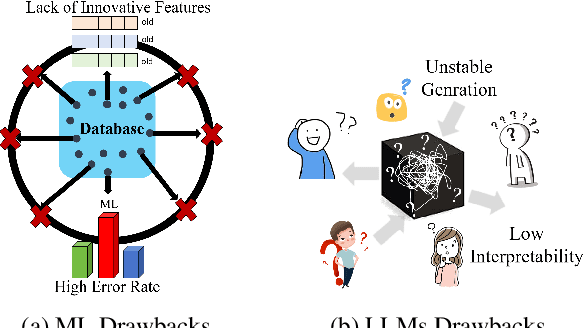
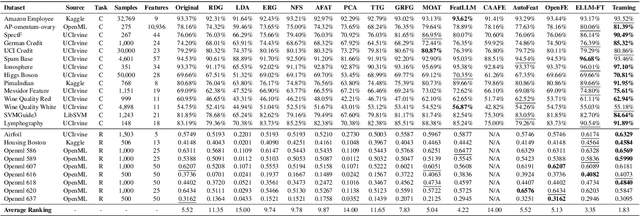
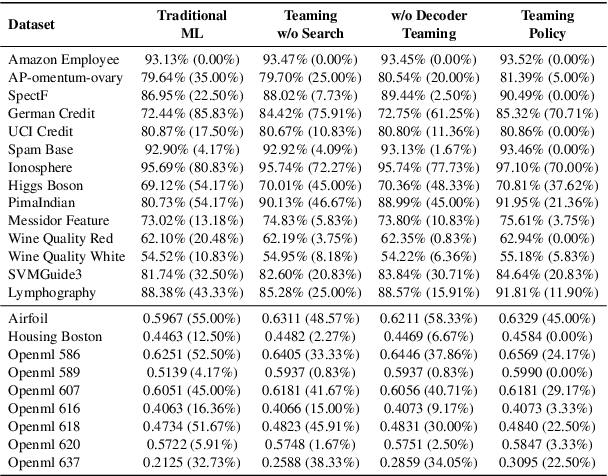
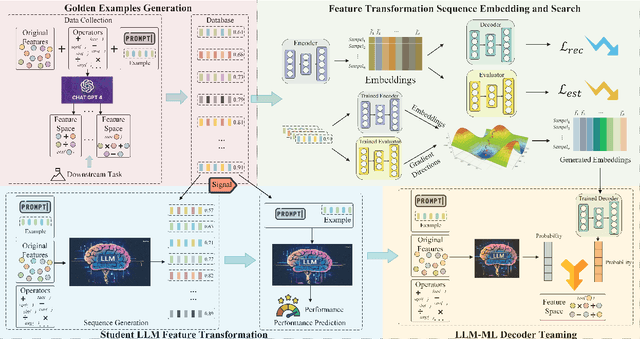
Abstract:Feature transformation enhances data representation by deriving new features from the original data. Generative AI offers potential for this task, but faces challenges in stable generation (consistent outputs) and valid generation (error-free sequences). Existing methods--traditional MLs' low validity and LLMs' instability--fail to resolve both. We find that LLMs ensure valid syntax, while ML's gradient-steered search stabilizes performance. To bridge this gap, we propose a teaming framework combining LLMs' symbolic generation with ML's gradient optimization. This framework includes four steps: (1) golden examples generation, aiming to prepare high-quality samples with the ground knowledge of the teacher LLM; (2) feature transformation sequence embedding and search, intending to uncover potentially superior embeddings within the latent space; (3) student LLM feature transformation, aiming to distill knowledge from the teacher LLM; (4) LLM-ML decoder teaming, dedicating to combine ML and the student LLM probabilities for valid and stable generation. The experiments on various datasets show that the teaming policy can achieve 5\% improvement in downstream performance while reducing nearly half of the error cases. The results also demonstrate the efficiency and robustness of the teaming policy. Additionally, we also have exciting findings on LLMs' capacity to understand the original data.
Efficient Post-Training Refinement of Latent Reasoning in Large Language Models
Jun 10, 2025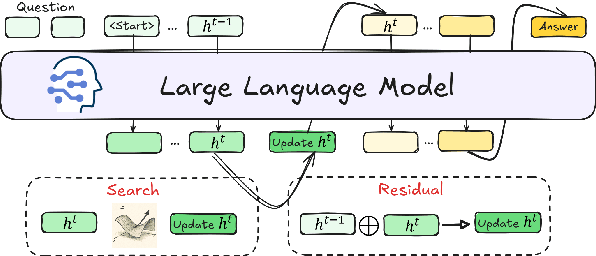
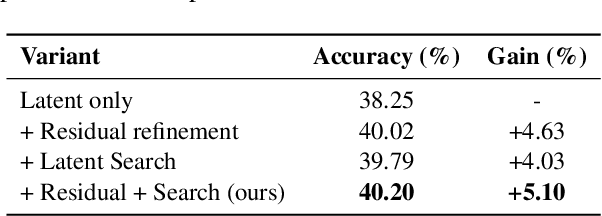
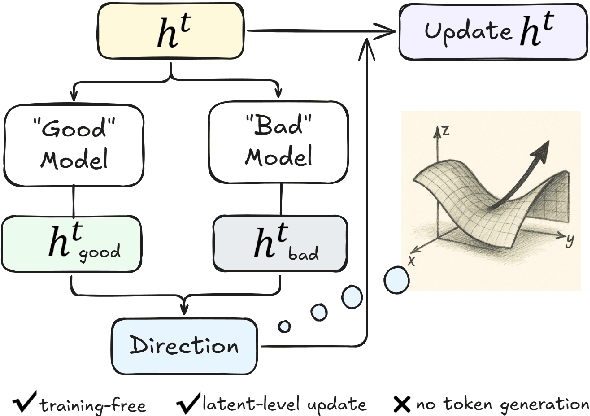
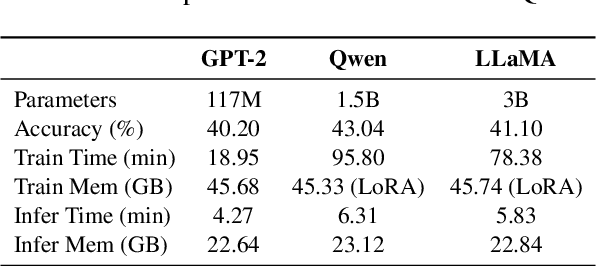
Abstract:Reasoning is a key component of language understanding in Large Language Models. While Chain-of-Thought prompting enhances performance via explicit intermediate steps, it suffers from sufficient token overhead and a fixed reasoning trajectory, preventing step-wise refinement. Recent advances in latent reasoning address these limitations by refining internal reasoning processes directly in the model's latent space, without producing explicit outputs. However, a key challenge remains: how to effectively update reasoning embeddings during post-training to guide the model toward more accurate solutions. To overcome this challenge, we propose a lightweight post-training framework that refines latent reasoning trajectories using two novel strategies: 1) Contrastive reasoning feedback, which compares reasoning embeddings against strong and weak baselines to infer effective update directions via embedding enhancement; 2) Residual embedding refinement, which stabilizes updates by progressively integrating current and historical gradients, enabling fast yet controlled convergence. Extensive experiments and case studies are conducted on five reasoning benchmarks to demonstrate the effectiveness of the proposed framework. Notably, a 5\% accuracy gain on MathQA without additional training.
Enhanced Whole Page Optimization via Mixed-Grained Reward Mechanism-Adapted Language Models
Jun 10, 2025Abstract:Optimizing the presentation of search and recommendation results is crucial to enhancing user experience and engagement. Whole Page Optimization (WPO) plays a pivotal role in this process, as it directly influences how information is surfaced to users. While Pre-trained Large Language Models (LLMs) have demonstrated remarkable capabilities in generating coherent and contextually relevant content, fine-tuning these models for complex tasks like WPO presents challenges. Specifically, the need for extensive human-annotated data to mitigate issues such as hallucinations and model instability can be prohibitively expensive, especially in large-scale systems that interact with millions of items daily. In this work, we address the challenge of fine-tuning LLMs for WPO by using user feedback as the supervision. Unlike manually labeled datasets, user feedback is inherently noisy and less precise. To overcome this, we propose a reward-based fine-tuning approach, PageLLM, which employs a mixed-grained reward mechanism that combines page-level and item-level rewards. The page-level reward evaluates the overall quality and coherence, while the item-level reward focuses on the accuracy and relevance of key recommendations. This dual-reward structure ensures that both the holistic presentation and the critical individual components are optimized. We validate PageLLM on both public and industrial datasets. PageLLM outperforms baselines and achieves a 0.44\% GMV increase in an online A/B test with over 10 million users, demonstrating its real-world impact.
 Add to Chrome
Add to Chrome Add to Firefox
Add to Firefox Add to Edge
Add to Edge